

Les espèces invasives : Discussion générale. Saving Native Wildlife with “Invasive” Plants. There’s been a lively discussion on permaculturists’ occasional planting of introduced species known to naturalize (or, in loaded terms, invasive species) at this blog.

Some there have disputed that exotics can play critical roles in habitat, and I posted the words below to show that removal of exotics can be very damaging to native wildlife: Here are hard data on introduced plants that have rapidly formed partnerships with native insects, from a paper, “Exotics as Host Plants of the California Butterfly Fauna,” by Sherri Graves and Arthur Shapiro, in Biological Conservation (2003) 110:413-433. It was sent to me by Mary McAllister, a SF blogger ( concerned about wholesale removal of healthy exotic trees from large swaths of rural SF-area parks. Invasive Plants in Permaculture. A couple of months ago, I posted on this site an article that reviewed three garden shows, noting that the third of these, the Ecological Landscaping Association’s Annual Conference, gave its attendees a thought-provoking paradox.
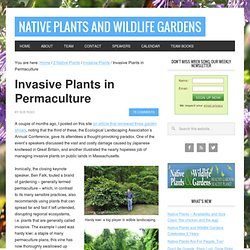
One of the event’s speakers discussed the vast and costly damage caused by Japanese knotweed in Great Britain, and another illustrated the nearly hopeless job of managing invasive plants on public lands in Massachusetts. Hardy kiwi: a big player in edible landscaping Kiwi escaped and on the loose in western Massachusetts Ironically, the closing keynote speaker, Ben Falk, touted a brand of gardening – generally termed permaculture – which, in contrast to its many sensible practices, also recommends using plants that can spread far and fast if left untended, disrupting regional ecosystems, i.e. plants that are generally called invasive. In response to my post, Mr. The ELA posted this lecture in their monthly newsletter, calling it a rebuttal to my piece. Permaflorae - Permaculture plant database. Le cycle de vie du Crosne du Japon — Site du Département de Biologie - ENS Lyon.
Le Crosne du Japon est un petit légume racine (nom générique pour tous les légumes qui poussent en terre) communément appelé crosne.
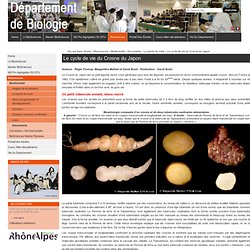
Venu en France en 1882, il fut rapidement cultivé en grand puis tomba peu à peu dans l'oubli à la fin du XXème siècle. Depuis quelques années, il réapparaît à nouveau sur les marchés d'hiver mais également en magasin, prêt à être cuisiné, ce qui dispense le consommateur du fastidieux nettoyage d'antan, où les tubercules étaient secoués et frottés dans un torchon avec du gros sel. Les légumes perpétuels - Le blog de permaculture.over-blog.fr. Native Plants: Restoring to an Idea. Let me tell you about the invasive plant that scares me more than all the others.
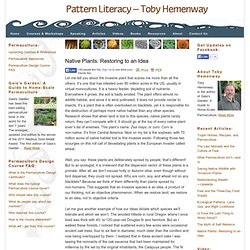
It’s one that has infested over 80 million acres in the US, usually in virtual monocultures. It is a heavy feeder, depleting soil of nutrients. Everywhere it grows, the soil is badly eroded. The plant offers almost no wildlife habitat, and since it is wind pollinated, it does not provide nectar to insects. It’s a plant that is often overlooked on blacklists, yet it is responsible for the destruction of perhaps more native habitat than any other species. 1+1=salade ? Production spontanée dans un jardin sauvage - Le Collectif de Permaculture Rhônes-Alpes en Isère. 26 août 2012 7 26 /08 /août /2012 15:29 Cela fait longtemps que je souhaite mettre en valeur mon jardin sauvage qui apparait comme une jungle inextricable lorsque l'on ne distingue pas les plantes les unes des autres.
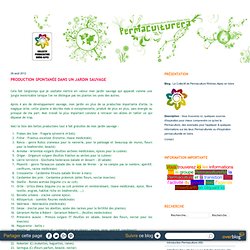
Après 4 ans de développement sauvage, mon jardin en plus de sa production importante d'ortie, la magique ortie, cette plante si décriée mais si exceptionnelle, produit de plus en plus, sans énergie ou presque de ma part. Mon travail le plus important consiste à retracer les allées et tailler ce qui dépasse de trop. Voici la liste des belles productions tout à fait gratuites de mon jardin sauvage : permaculture-ra.over-blog.com - dans Jardin des Bruyères. Le chloroplaste : un p'tit grain vert plein de mystères... Végétaux. Weed Identification. Botanique. Agroforesterie & Foret fruitière.
Grains. Human / Pasture, Browsing, Forage. Vegetables Garden. Bee Forage. Fruits / Nuts Orchard. Medecines. Paradize.ws - La Liberté Sans Limite Téléchargement de Films sur Megaupload. L'ortie. Infos L'ortie Pour la version imprimable, cliquez ici Quantité d'articles apologétiques ont été écrits à propos de l'ortie, notamment dans le cadre de ses applications jardinières.
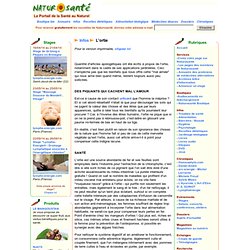
Ceci n'empêche pas que les bienfaits que nous offre cette "mal aimée" qui nous aime bien quand même, restent toujours aussi peu sollicités. Syndicat des Simples.
Polyculture Guilds & PhytoSociology & Companion Planting. Pionniers Species / Weeds. Collective Plant Database * Plant For A Future. To the best of our knowledge all the information contained herein is accurate and true.

However we cannot guarantee that everyone will react positively to all edible plants or other plant uses. It is commonly known that many people suffer allergic reactions to conventional foods and products. Even amongst the more commonly eaten fruits, for example, there are plenty of instances where people react badly to them: Many people are allergic to strawberries and will come out in a rash if they eat them.Some people develop a rash if they touch the stems of parsnips. Potatoes become poisonous if they turn green.Eating large quantities of cabbage can adversely affect the thyroid gland. We strongly recommend the following preventative precautions when trying anything new: Make sure you have identified the plant correctlyTry a small taste of anything new in your diet.